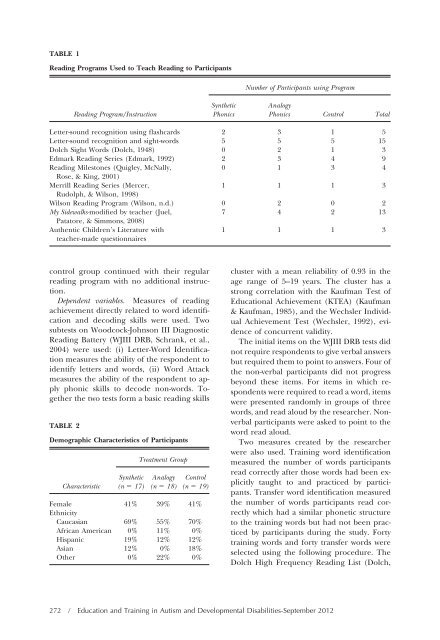etadd_47(3) - Division on Autism and Developmental Disabilities
etadd_47(3) - Division on Autism and Developmental Disabilities
etadd_47(3) - Division on Autism and Developmental Disabilities
Create successful ePaper yourself
Turn your PDF publications into a flip-book with our unique Google optimized e-Paper software.
TABLE 1<br />
Reading Programs Used to Teach Reading to Participants<br />
Reading Program/Instructi<strong>on</strong><br />
c<strong>on</strong>trol group c<strong>on</strong>tinued with their regular<br />
reading program with no additi<strong>on</strong>al instructi<strong>on</strong>.<br />
Dependent variables. Measures of reading<br />
achievement directly related to word identificati<strong>on</strong><br />
<strong>and</strong> decoding skills were used. Two<br />
subtests <strong>on</strong> Woodcock-Johns<strong>on</strong> III Diagnostic<br />
Reading Battery (WJIII DRB, Schrank, et al.,<br />
2004) were used: (i) Letter-Word Identificati<strong>on</strong><br />
measures the ability of the resp<strong>on</strong>dent to<br />
identify letters <strong>and</strong> words, (ii) Word Attack<br />
measures the ability of the resp<strong>on</strong>dent to apply<br />
ph<strong>on</strong>ic skills to decode n<strong>on</strong>-words. Together<br />
the two tests form a basic reading skills<br />
Synthetic<br />
Ph<strong>on</strong>ics<br />
Number of Participants using Program<br />
Analogy<br />
Ph<strong>on</strong>ics C<strong>on</strong>trol Total<br />
Letter-sound recogniti<strong>on</strong> using flashcards 2 3 1 5<br />
Letter-sound recogniti<strong>on</strong> <strong>and</strong> sight-words 5 5 5 15<br />
Dolch Sight Words (Dolch, 1948) 0 2 1 3<br />
Edmark Reading Series (Edmark, 1992) 2 3 4 9<br />
Reading Milest<strong>on</strong>es (Quigley, McNally,<br />
Rose, & King, 2001)<br />
0 1 3 4<br />
Merrill Reading Series (Mercer,<br />
Rudolph, & Wils<strong>on</strong>, 1998)<br />
1 1 1 3<br />
Wils<strong>on</strong> Reading Program (Wils<strong>on</strong>, n.d.) 0 2 0 2<br />
My Sidewalks-modified by teacher (Juel,<br />
Patatore, & Simm<strong>on</strong>s, 2008)<br />
7 4 2 13<br />
Authentic Children’s Literature with<br />
teacher-made questi<strong>on</strong>naires<br />
1 1 1 3<br />
TABLE 2<br />
Demographic Characteristics of Participants<br />
Characteristic<br />
Synthetic<br />
(n 17)<br />
Treatment Group<br />
Analogy<br />
(n 18)<br />
C<strong>on</strong>trol<br />
(n 19)<br />
Female 41% 39% 41%<br />
Ethnicity<br />
Caucasian 69% 55% 70%<br />
African American 0% 11% 0%<br />
Hispanic 19% 12% 12%<br />
Asian 12% 0% 18%<br />
Other 0% 22% 0%<br />
cluster with a mean reliability of 0.93 in the<br />
age range of 5–19 years. The cluster has a<br />
str<strong>on</strong>g correlati<strong>on</strong> with the Kaufman Test of<br />
Educati<strong>on</strong>al Achievement (KTEA) (Kaufman<br />
& Kaufman, 1985), <strong>and</strong> the Wechsler Individual<br />
Achievement Test (Wechsler, 1992), evidence<br />
of c<strong>on</strong>current validity.<br />
The initial items <strong>on</strong> the WJIII DRB tests did<br />
not require resp<strong>on</strong>dents to give verbal answers<br />
but required them to point to answers. Four of<br />
the n<strong>on</strong>-verbal participants did not progress<br />
bey<strong>on</strong>d these items. For items in which resp<strong>on</strong>dents<br />
were required to read a word, items<br />
were presented r<strong>and</strong>omly in groups of three<br />
words, <strong>and</strong> read aloud by the researcher. N<strong>on</strong>verbal<br />
participants were asked to point to the<br />
word read aloud.<br />
Two measures created by the researcher<br />
were also used. Training word identificati<strong>on</strong><br />
measured the number of words participants<br />
read correctly after those words had been explicitly<br />
taught to <strong>and</strong> practiced by participants.<br />
Transfer word identificati<strong>on</strong> measured<br />
the number of words participants read correctly<br />
which had a similar ph<strong>on</strong>etic structure<br />
to the training words but had not been practiced<br />
by participants during the study. Forty<br />
training words <strong>and</strong> forty transfer words were<br />
selected using the following procedure. The<br />
Dolch High Frequency Reading List (Dolch,<br />
272 / Educati<strong>on</strong> <strong>and</strong> Training in <strong>Autism</strong> <strong>and</strong> <strong>Developmental</strong> <strong>Disabilities</strong>-September 2012

















